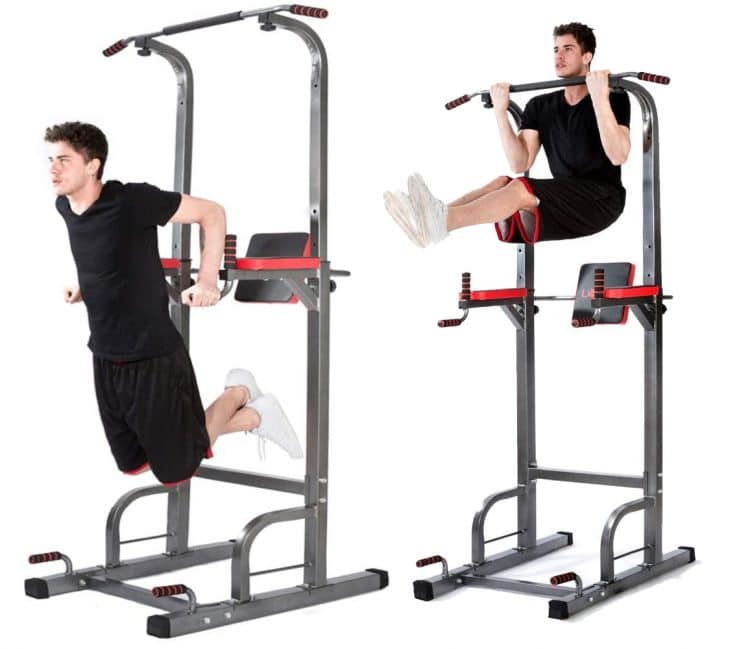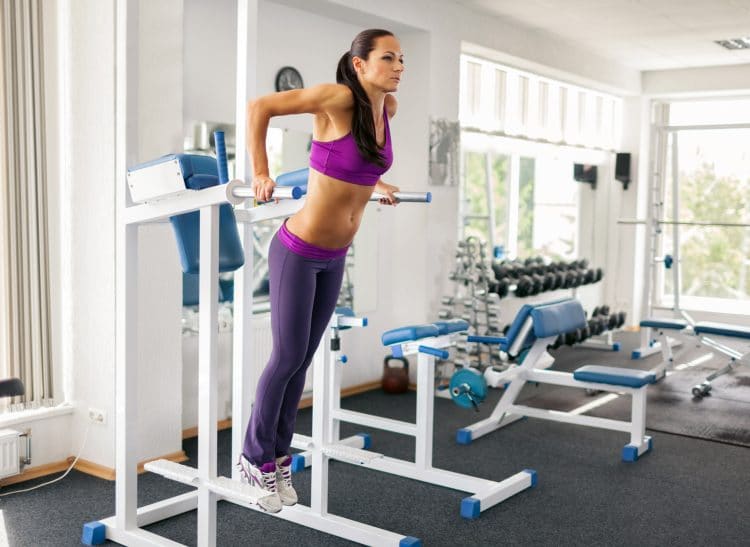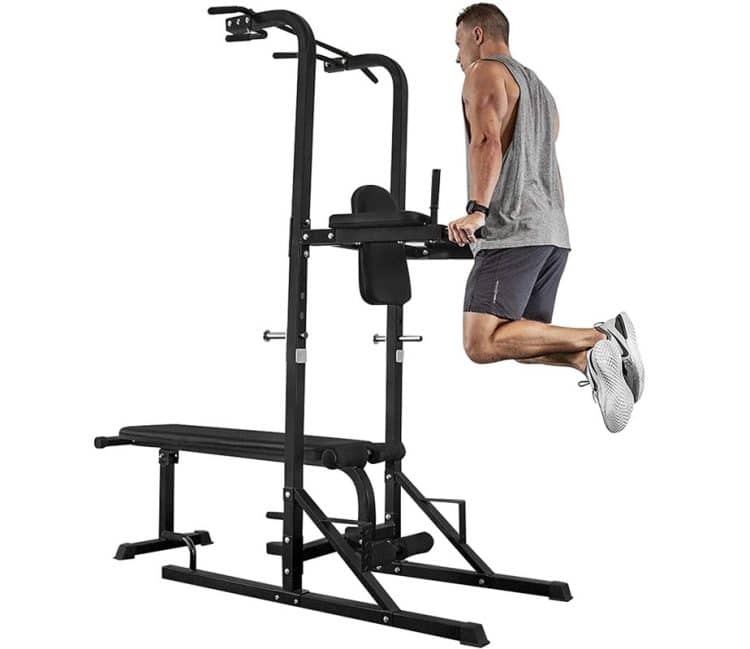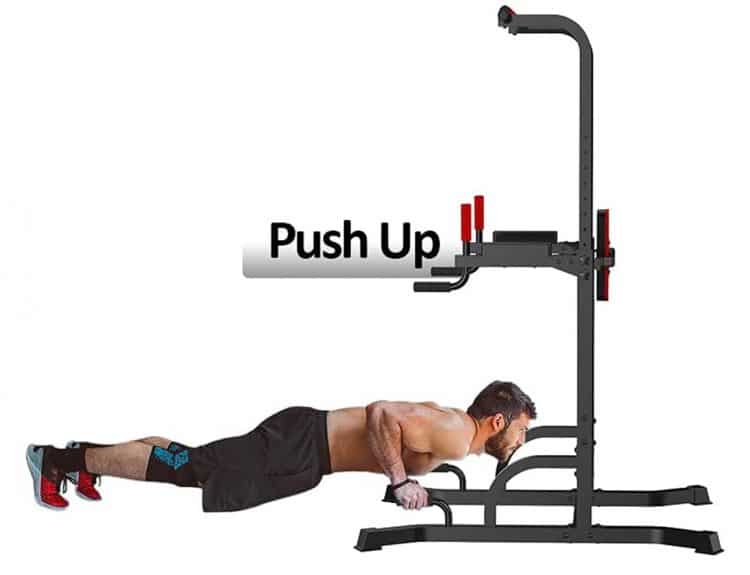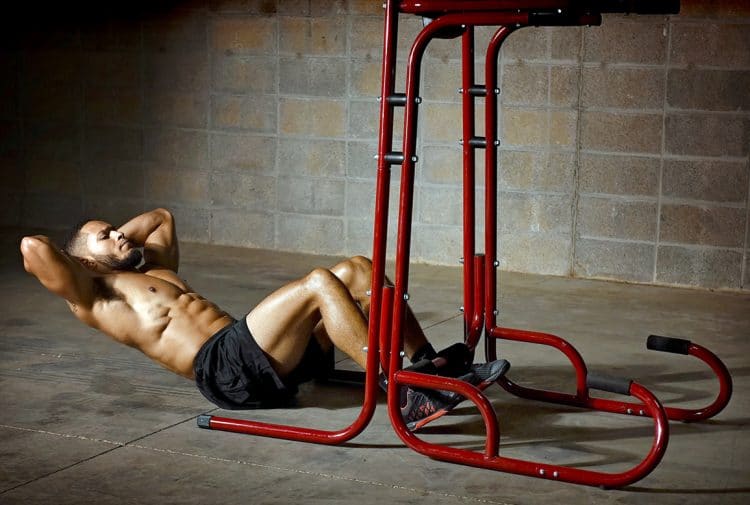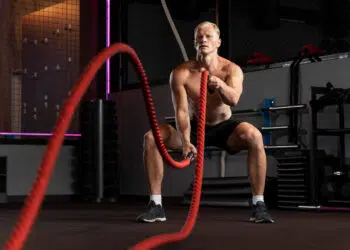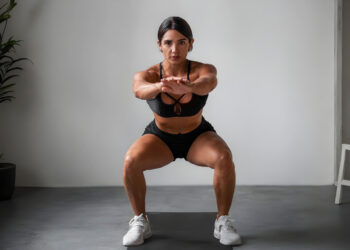I’m not sure who invented power towers, but I’m delighted they did! Since hanging up my powerlifting singlet a couple of years ago, I now mainly work out at home and have swapped heavy barbell workouts for bodyweight and kettlebell training.
Having a power tower means I can do exercises like pull-ups, dips, and knee raises whenever I want to and in the comfort of my own home.
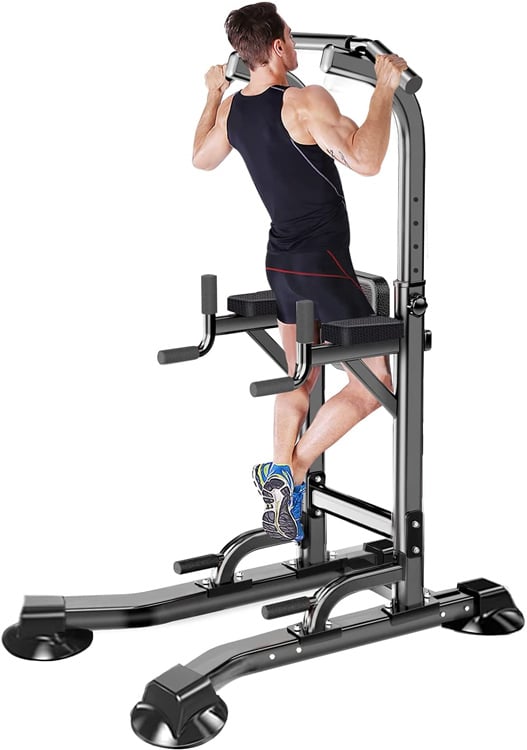
It would be easy to see training with a power tower as quite limiting, but, in reality, it doesn’t have to be. While you might not have such a wide choice of exercises to choose from, there are lots of ways to organize your sets and reps to keep your workouts varied and interesting.
In this article, I’m going to share my favorite power tower workout so you can get more from this fantastic training tool.
What Is A Power Tower?
A power tower is a freestanding workout station that allows you to do a range of bodyweight exercises. They’re relatively compact, so they don’t require much space to use, and can be pretty affordable too.
Level Up Your Fitness: Join our 💪 strong community in Fitness Volt Newsletter. Get daily inspiration, expert-backed workouts, nutrition tips, the latest in strength sports, and the support you need to reach your goals. Subscribe for free!
Made mainly for home use, most power towers come disassembled, so you need to put them together yourself. But, once you’ve built your power tower, it’ll be there for you to use day or night; power tower home gyms are open 24/7!
While power tower designs vary, most allow you to do the following exercises:
- Pull-ups
- Chin-ups
- Triceps dips
- Chest dips
- Neutral-grip push-ups
- Captain’s chair leg raises (straight leg and bent leg)
- Body rows
- Sit-ups
Combine these movements with some bodyweight leg exercises, and you really can train your entire body in just a few yards of space.
Because there is nothing to set up, you can move quickly from one exercise to the next, which makes for a very time-efficient workout. Power towers are ideal for circuit training and HIIT, so you can use them to build muscle as well as burn fat.
If you work out at home and want to add an extra dimension to your workouts, buying a power tower is a GREAT idea!
Related: 10 Best Power Towers Reviewed for 2024
The Ultimate Power Tower Workouts
This workout is designed to be done three times a week. It’s a full-body plan that combines power tower exercises with bodyweight lower body training.
Because your exercise choices are somewhat limited when you’ve just got a power tower to work with, each training day uses a different set/rep scheme. This will provide you with the variety necessary for building muscle while warding off boredom.
- Ascending ladders (e.g., Monday)
- Myo-reps (e.g., Wednesday)
- 50% AMRAP sets (e.g., Friday)
Of course, before you start any workout, you need to spend a few minutes warming up to prepare your muscles and joints and ward off injury. Do some light cardio for 5-10 minutes, such as jumping rope or step-ups, and then a few dynamic stretching and mobility exercises for your main muscles and joints.
For each workout, do the following exercises:
- Chin-ups/pull-ups
- Dips
- Bodyweight lunge complex
- Body rows
- Push-ups
- Bodyweight squat complex
- Bent-leg sit-ups
- Twisting single-leg knee raises
Workout One – Ascending Ladders
For your first power tower workout, we’re going to use a training system called ascending ladders.
To do an ascending ladder, you do one rep, take a breath, do two reps, take another breath, and keep adding one rep until you reach failure. Rest 1-2 minutes, and then start back at the bottom of your ladder and repeat. Do three ladder ascents per upper body exercise (chin-ups/pull-ups), dips, body rows, and push-ups.
For the leg and abs exercises, do three sets of 8-20 reps depending on your fitness, resting 60-90 seconds between sets.
Workout Two – Myo-reps
Your second power tower workout uses the myo-reps training system. The idea behind myo-reps is to take your muscles to failure and then keep them there for several micro sets to deliver an intense, time-efficient workout.
To do myo-reps, after you’ve warmed up, do your first exercise to failure. Rest 15-20 seconds and then rep out again, doing 25% of the reps of your first set. Rest another 15-20 seconds and then do another mini-set. Continue until you have done five micro sets or cannot hit 25% of your initial set.
Here’s an example of myo-reps for pull-ups:
- 12 reps (failure)
- Rest 20 seconds
- 3 reps (25% of 12)
- Rest 20 seconds
- 3 reps
- Rest 20 seconds
- 3 reps
- Rest 20 seconds
- 3 reps
- Rest 20 seconds
- 3 reps
Because myo-reps are so intense, you only do one run-through per exercise.
Related: Myo-Reps Workout for Muscle Size and Strength
For the leg and abs exercises, do three sets of 8-20 reps depending on your fitness, resting 60-90 seconds between sets.
Workout Three – 50% AMRAP Sets
For your final power tower workout, you’re going to use a training method called 50% AMRAP sets. In simple terms, you do a set to failure, rest precisely 60 seconds, and then rep out to failure again. Because of residual fatigue, you won’t be able to do as many reps. Rest for 60 seconds again and repeat. Continue until you are unable to do 50% of your initial set.
Level Up Your Fitness: Join our 💪 strong community in Fitness Volt Newsletter. Get daily inspiration, expert-backed workouts, nutrition tips, the latest in strength sports, and the support you need to reach your goals. Subscribe for free!
Here’s an example for dips:
- 16 reps
- Rest 60 seconds
- 13 reps
- Rest 60 seconds
- 10 reps
- Rest 60 seconds
- 8 (50% of 16)
For the leg and abs exercises, do three sets of 8-20 reps depending on your fitness, resting 60-90 seconds between sets.
Exercise Descriptions
Get the most from your power tower workouts by doing each exercise correctly. Proper workout form will also minimize your risk of injury.
1. Chin-ups/Pull-ups
Target muscles: Latissimus dorsi, biceps
Upper back and biceps exercises don’t come much better than chin-ups and pull-ups. These exercises are largely interchangeable, so do whichever one you prefer. Alternatively, do pull-ups for one workout and chin-ups for the next, alternating through your training week.
How to do it:
- Hang from your bar using a wider than shoulder-width overhand grip (pull-ups) or a narrower than shoulder-width underhand grip (chin-ups). Bend your legs to lift your feet clear of the floor. Brace your abs and pull your shoulders down and back.
- Without swinging or kicking, bend your arms and pull your chin up and over the bar.
- Descend under control and repeat.
- If you can’t do pull-ups or chin-ups, tie a resistance band to your bar and stand or kneel in it for assistance.
2. Dips
Target muscles: Pectoralis major, deltoids, triceps
Dips compare favorably to bench presses and other freeweight and machine chest exercises. They can be a little hard on your shoulders, so don’t descend too far. As with pull-ups/chin-ups, you can make dips easier by using a resistance band for assistance.
How to do it:
- Grab the dipping bars with your palms facing inward. Step up and support your weight on straight arms. Bend your legs so your feet won’t touch the floor between reps. Brace your abs and push your shoulders down and back.
- Bend your arms and descend until your elbows are bent to about 90 degrees.
- Push yourself back up and repeat.
- Keep your torso relatively upright to emphasize your triceps, or lean forward to increase chest engagement.
3. Bodyweight Lunge Complex
Target muscles: Quadriceps, hamstrings, gluteus maximus, abductors, adductors
When you don’t have a lot of weight to use, the only way to overload your muscles is with lots of reps and short rests. While not ideal for building bigger muscles or increasing strength, this approach should still deliver an effective workout. For this complex, you are going to do three types of lunges – forward, backward, and jumping.
How to do it:
- Stand with your feet together and your arms by your side. Brace your core.
- Take a large step forward, bend your legs, and lower your rearmost knee down to within an inch of the floor. Push off your front leg and return to the standing position. Do your next rep with the opposite leg, and then alternate for the required number of reps.
- Without resting, step back and into a backward lunge. Again, lower your rear knee down to within an inch of the floor. Push off your back leg and return to the standing position. Do your next rep with the opposite leg, and then alternate for the required number of reps.
- Finally, step forward with one leg, descend until your knee back knee is just above the floor, and then jump up into the air. Switch legs, so you land with your feet reversed, and then repeat. Continue for the required number of reps.
- That’s one complex complete; rest a moment and then repeat.
4. Inverted Rows
Target muscles: Latissimus dorsi, biceps
Inverted rows are a useful alternative for or supplement to pull-ups and chin-ups. They’re a little easier, so it makes sense to do them later in your workout when your back and biceps are tired.
How to do it:
- Place a chair or step out in front of your power tower. If your dip bars are low to the ground, you may not need to raise your feet.
- With your back to your power tower, squat down beneath the dip bars and hold them with a parallel grip, palms turned inward. Keeping your arms extended, place your feet on the chair and straighten your legs and body. Brace your core and pull your shoulders down and back.
- Keeping your body straight, bend your arms and pull your chest up until it’s level with your hands. Extend your arms and repeat.
- Give yourself a target for your chest by placing a broomstick across your dipping bars. This will ensure you use the same range of motion for each rep.
5. Push-ups
Target muscles: Pectoralis major, deltoids, triceps
Like dips, push-ups are an effective bodyweight chest, shoulder, and triceps exercise. Most power towers have raised parallel grips so you can lower your chest down between your hands to get a deeper stretch and more intense workout. You can also make push-ups more challenging by placing your feet on a chair or step.
How to do it:
- Squat down and grab the parallel handles, palms facing inward.
- Walk your feet back, so your body is straight. Brace your abs and pull your shoulders down and back.
- Bend your elbows and lower chest down toward the floor, taking care not to hyperextend your shoulders. Keep your upper arms close to your sides.
- Push yourself back up and repeat.
- Bend your legs and rest on your knees to make push-ups easier.
6. Bodyweight Squat Complex
Target muscles: Quadriceps, hamstrings, gluteus maximus, abductors, adductors
This complex combines three types of squats to deliver an effective leg workout without weights – sumo squats, prisoner squats, and squat jumps.
How to do it:
- Stand with your feet about 1.5 shoulder-widths apart, toes turned out. Hold your hands together in front of your hips.
- Bend your legs and squat down, touching the floor with your fingertips. Push your knees out to engage your outer hips and thighs. Do not round your lower back. Stand back up and repeat for the required number of reps.
- Move your feet into shoulder-width apart and place your hands on your temples. Press your elbows back to open your chest.
- Squat down until your thighs are roughly parallel to the floor. Do not round your lower back. Stand back up and repeat. Continue for the prescribed number of reps.
- Lastly, with your arms by your sides, squat down and then jump up into the air as high as you can, reaching above your head and you leap. Land on slightly bent knees and repeat.
- That’s one complex complete; rest a moment and then repeat.
7. Bent-leg Sit-ups
Target muscles: Rectus abdominis, hip flexors
Bent-leg sit-ups have fallen out of favor recently because they work your hip flexors as much as your abs. However, that’s how your abs often work in nature, so they’re not the useless exercise that some people believe. However, sit-ups CAN be hard on your lower back, so do bent-leg crunches instead if you find this exercise uncomfortable.
How to do it:
- Lie on the floor with your legs bent and feet flat. Anchor your feet under the restraints on your power tower. Place your hands on your temples, and NOT behind your head.
- Using your abs and hip flexors together, flex your spine and hips and sit up, touching your elbows to your bent knees.
- Lie back down and repeat.
8. Twisting Single-leg Knee Raises
Target muscles: Rectus abdominis, obliques, hip flexors
After sit-ups, your rectus abdominis should be nicely fatigued, so it’s time to work on your other main abs muscle, the obliques. Do this exercise slowly and with control to maximize oblique engagement.
How to do it:
- Support your weight on the forearm pads and let your legs hang down. Brace your abs.
- Bend one leg and take your knee up and across to your opposite hand. Use your obliques to lift your hip up as you twist.
- Return to the starting position and then repeat on the opposite side.
Power Tower Workout – Wrapping Up
A lot of people think that you need masses of training equipment to build muscle and strength. And while there is nothing wrong with working out in a well-equipped gym, you can get great results training at home, too.
Ultimately, your body has a hard time telling the difference between doing lat pulldowns on a $20,000 machine and pull-ups on a $200 power tower. It just knows muscle tension and work. Providing you train hard and consistently, your body will adapt to whatever exercises you do.
If you want to create the ultimate home gym, a power tower deserves to be near the top of your shopping list. In fact, if that’s the only thing you buy, you’ll still have everything you need to build muscle and get fit in the comfort of your own home.

